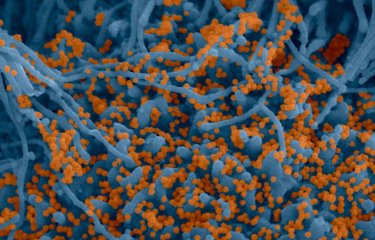-
Report | 2020.04.03
Coronavirus SARS-CoV-2: A look back at three months of mobilisation against an emerging disease (COVID-19)
On December 31, 2019, the WHO China Country Office was informed of cases of pneumonia of unknown etiology (unknown cause) detected in Wuhan City, Hubei Province of China. It was the official beginning of an epidemic that would rapidly become worldwide. In January, a task force was put in place at the Institut Pasteur and research projects were quickly launched. Here is a look back at three...
-
Article | 2020.06.22
Investigation of the first cases of coronavirus (COVID-19) infections and their contacts in Antananarivo, Madagascar
Aim: This study aims to understand the epidemiologic, clinical, virologic and immunologic characteristics of first infected cases, their evolution and household transmission. It is intended to follow confirmed infected cases and their household members. It will be conducted with clinicians from three hospital centers of Antananarivo.
-
Article | 2020.07.07
LuLISA project, bioluminescence as a tool for human diagnostics, from allergy to Covid19
LuLISA project, bioluminescence as a tool for human diagnostics, from allergy to Covid19
-
Article | 2020.07.07
CEPI collaborates with the Institut Pasteur in a consortium to develop Covid-19 vaccine
CEPI collaborates with the Institut Pasteur in a consortium to develop Covid-19 vaccine
-
Article | 2020.07.07
COVID-19: mathematical model indicates that between 3% and 7% of French people have been infected
COVID-19: mathematical model indicates that between 3% and 7% of French people have been infected
-
News | 2022.07.11
A snapshot of 2021's highlights
Following the release of the 2021 edition of the Institut Pasteur's Annual Report, here are some of the year's highlights. Twelve eventful months interspersed with highlightsmajor scientific breakthroughs and key events for the institute in all fields including COVID-19, cancer, neuroscience, genetics, vaccinology and antibiotic resistance.
-
News | 2023.08.23
Distinct immune responses reveal two major types of long COVID
Although the biological mechanisms behind the short-term effects of COVID-19 are now known, the same is not true for long COVID. Scientists have recently demonstrated that individuals with this syndrome can present different immune responses, either weak or strong. This is a first step in improving treatment for patients with no apparent immunological traces of SARS-CoV-2 infection.
-
News | 2024.12.09
Lessons learned from the COVID-19 crisis: improving protection through early response, rapid tracking and impact monitoring
Scientific experts from 13 Western European countries have recently completed a review of key lessons learned from the way the COVID-19 pandemic was handled. Two key findings have emerged. Firstly, death rates were lower in countries that took measures early. Secondly, the need for a surveillance system capable of quickly tracking the community spread of a virus and its impact on hospitals was...
-
Article | 2020.06.16
The use of Artificial Intelligence Methods to Discriminate Covid-19 from other Community Acquired Pneumopathy using Chest X-Ray and CT images
Aim: Diagnostic of SARS-CoV-2 Coronavirus caused-disease (Covid-19) is a bottleneck in the immediate follow-up of patients. We propose automated detection methods based on Artificial Intelligence (AI) Algorithms (Machine Learning and Form Recognition), on chest Computed tomography (CT) or X-Ray images, to discriminate the Covid-19 disease from other Community Acquired Pneumonia (CAP). The methods...
-
Document de presse | 2020.11.03
Number of Covid-19 deaths in the under-65s: a more reliable indicator for assessing infection rates in populations
Simply comparing the total number of deaths across countries may provide a misleading representation of the underlying level of transmission of SARS-CoV-2, the virus that causes COVID-19, because of large differences in reported COVID-19 death rates in elderly populations in different countries.The research conducted by the University of Cambridge, the Institut Pasteur and the CNRS, published...

